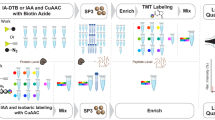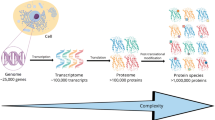Abstract
The O-linked β-N-acetylglucosamine (O-GlcNAc) modification is an abundant post-translational modification in eukaryotic cells. This dynamic glycosylation plays a fundamental role in the activity of many nuclear and cytoplasmic proteins and is associated with pathologies like type II diabetes, Alzheimer’s disease or some cancers. However the exact link between O-GlcNAc-modified proteins and their function in cells is largely undefined for most cases. Here we report a strategy based on the 1,3-dipolar cycloaddition, called click chemistry, between unnatural N-acetylglucosamine (GlcNAc) analogues (substituted with an azido or alkyne group) and the corresponding biotinylated probe to specifically detect, enrich and identify O-GlcNAc-modified proteins. This bio-orthogonal conjugation confirms that only azido analogue of GlcNAc is metabolized by the cell. Thanks to the biotin probe, affinity purification on streptavidin beads allowed us to identify 32 O-GlcNAc-azido-tagged proteins by LC-MS/MS analysis in an MCF-7 cellular model, 14 of which were previously unreported. This work illustrates the use of the click-chemistry-based strategy combined with a proteomic approach to get further insight into the pattern of O-GlcNAc-modified proteins and the biological significance of this post-translational modification.

Detection of biotinylated O-GlcNAz proteins in MCF-7 cells



Similar content being viewed by others
References
Torres CR, Hart GW (1984) J Biol Chem 259:3308–3317
Wells L, Vosseller K, Hart GW (2001) Science 291:2376–2378
Iyer SP, Hart GW (2003) Biochemistry 42:2493–2499
Liu F, Iqbal K, Grundke-Iqbal I, Hart GW, Gong CX (2004) Proc Natl Acad Sci USA 101:10804–10809
Konrad RJ, Kudlow JE (2002) Int J Mol Med 10:535–539
Vocadlo DJ, Hang HC, Kim EJ, Hanover JA, Bertozzi CR (2003) Proc Natl Acad Sci USA 100:9116–9121
Speers AE, Adam GC, Cravatt BF (2003) J Am Chem Soc 125:4686–4687
Speers AE, Cravatt BF (2004) Chem Biol 11:535–546
Kolb HC, Finn MG, Sharpless KB (2001) Angew Chem Int Ed Engl 40:2004–2021
Bock DV, Hiemstra H, van Maarseveen JH (2006) Eur J Org Chem 2006:51–68
Kolb HC, Sharpless KB (2003) Drug Discov Today 8:1128–1137
Rostovtsev VV, Green LG, Fokin VV, Sharpless KB (2002) Angew Chem Int Ed Engl 41:2596–2599
Agard NJ, Baskin JM, Prescher JA, Lo A, Bertozzi CR (2006) ASC Chem Biol 1:644–648
Rybak JN, Scheurer SB, Neri D, Elia G (2004) Proteomics 4:2296–2299
Wang Q, Chan TR, Hilgraf R, Fokin VV, Sharpless KB, Finn MG (2003) J Am Chem Soc 125:3192–3193
Link AJ, Tirrell DA (2003) J Am Chem Soc 125:11164–11165
Gupta SS, Kuzelka J, Singh P, Lewis WG, Manchester M, Finn MG (2005) Bioconjugate Chem 16:1572–1579
Sprung R, Nandi A, Chen Y, Kim SC, Barma D, Falck JR, Zhao Y (2005) J Proteome Res 4:950–957
Sawa M, Hsu TL, Itoh T, Sujiyama M, Hanson SR, Vogt PK, Wong CH (2006) Proc Natl Acad Sci USA 103:12371–12376
Perreira M, Kim EJ, Thomas CJ, Hanover JA (2006) Bioorg Med Chem 14:837–846
Jitrapakdee S, Wallace JC (1999) Biochem J 340:1–16
Smith S, Witkowski A, Joshi AK (2003) Prog Lipid Res 42:289–317
Nandi A, Sprung R, Barma DK, Zhao Y, Kim SC, Falck JR, Zhao Y (2006) Anal Chem 78:452–458
Ku NO, Omary MB (1995) J Biol Chem 270:11820–11827
Walgren JL, Vincent LS, Schey KL, Buse MG (2003) Am J Physiol Endocrinol Metab 284:E424–E434
Wells L, Vosseler K, Cole RN, Cronshaw JM, Matunis MJ, Hart GW (2002) Mol Cell Proteomics 1:791–804
Zachara NE, Hart GW (2004) Biochim Biophys Acta 1673:13–28
Acknowledgements
The authors are grateful to Sébastien Vidal, Philippe Belmont and Tony Lefebvre for helpful discussions, to Peter Goekjian for critical reading of the manuscript and to Adeline Page for nano-HPLC-MS/MS experiments.
Author information
Authors and Affiliations
Corresponding author
Additional information
Caroline Gurcel and Anne-Sophie Vercoutter-Edouart contributed equally to this work.
Electronic supplementary material
Below is the link to the electronic supplementary material.
ESM
(PDF 96.2 kb)
Rights and permissions
About this article
Cite this article
Gurcel, C., Vercoutter-Edouart, AS., Fonbonne, C. et al. Identification of new O-GlcNAc modified proteins using a click-chemistry-based tagging. Anal Bioanal Chem 390, 2089–2097 (2008). https://doi.org/10.1007/s00216-008-1950-y
Received:
Revised:
Accepted:
Published:
Issue Date:
DOI: https://doi.org/10.1007/s00216-008-1950-y




